tow Citroen DS5 HYBRID4 2013 1.G Owner's Guide
[x] Cancel search | Manufacturer: CITROEN, Model Year: 2013, Model line: DS5 HYBRID4, Model: Citroen DS5 HYBRID4 2013 1.GPages: 364, PDF Size: 10.21 MB
Page 150 of 364
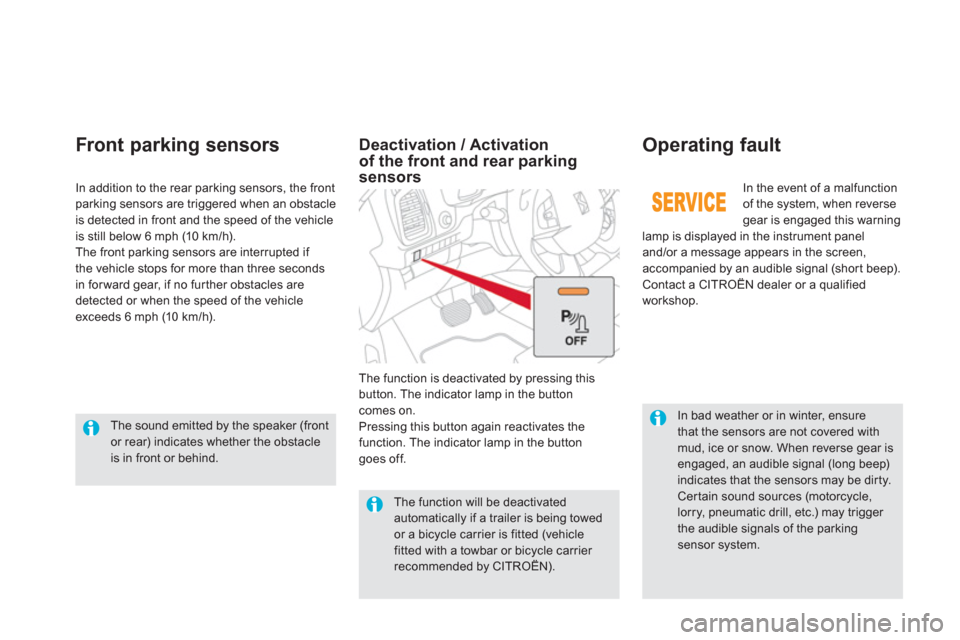
In bad weather or in winter, ensure that the sensors are not covered with mud, ice or snow. When reverse gear isengaged, an audible signal (long beep)indicates that the sensors may be dirty. Cer tain sound sources (motorcycle,lorry, pneumatic drill, etc.) may trigger the audible signals of the parkingsensor system.
In th
e event of a malfunctionof the system, when reverse gear is engaged this warning
lamp is displayed in the instrument paneland/or a message appears in the screen,
accompanied by an audible signal (short beep).
Contact a CITROËN dealer or a qualified
workshop.
Operating fault
In addition to the rear parking sensors, the front parking sensors are triggered when an obstacle
is detected in front and the speed of the vehicle
is still below 6 mph (10 km/h).
The front parking sensors are interrupted if
the vehicle stops for more than three seconds
in for ward
gear, if no fur ther obstacles are
detected or when the speed of the vehicle
exceeds 6 mph (10 km/h).
Front par king sensors
The function will be deactivated automatically if a trailer is being towed or a bicycle carrier is fitted (vehicle fitted with a towbar or bicycle carrier recommended by CITROËN).
Deactivation / Activationof the front and rear parking sensors
The function is deactivated by pressing thisbutton. The indicator lamp in the button comes on.
Pressing this button again reactivates the
function. The indicator lamp in the button
goes off.
The sound emitted by the speaker (front
or rear) indicates whether the obstacle is in front or behind.
Page 165 of 364

163Visibility
Wiper controls
Programming
Various automatic wiper control modes are also
available according to the following options:
- automatic rain sensitive windscreen wipers,
- rear w
iping on engaging reverse gear.
Manual controls
The wipers are controlled directly by the driver. The vehicle's
front and rear wipers are
designed to improve the driver's visibility
progressively according to the climaticconditions.
Windscreen wipers
Wiping speed:
fast
(heavy rain),
normal
(moderate rain),
intermittent
(proportional to the
speed of the vehicle),
park,
automatic
(press down and
release),
single wipe
(pull the stalk briefly towards you).
Page 166 of 364
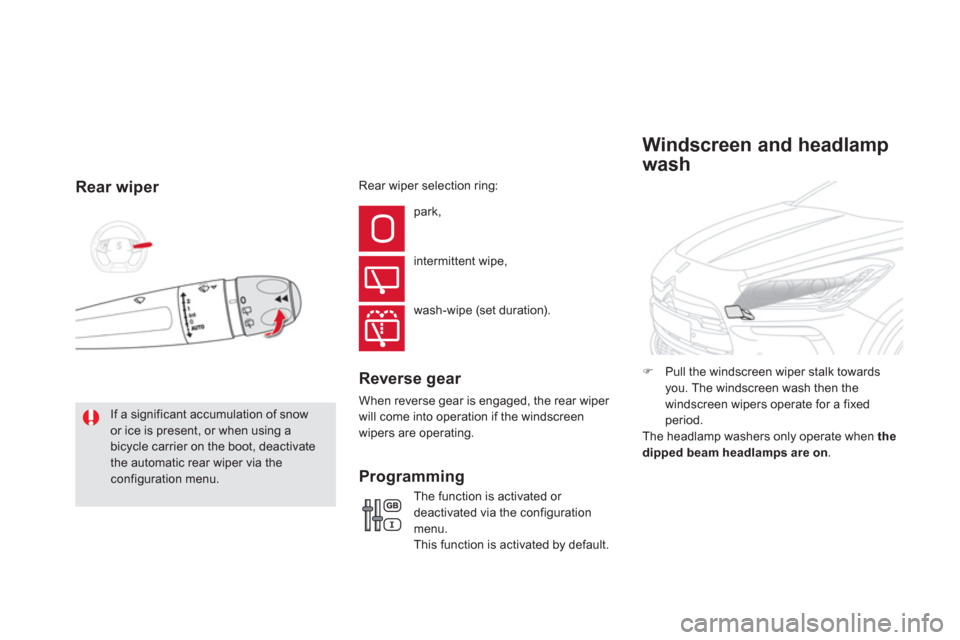
Rear wiper
If a significant accumulation of snowor ice is present, or when using a bicycle carrier on the boot, deactivatethe automatic rear wiper via theconfiguration menu. park,
intermittent wipe,
wash-wipe
(set duration).
Reverse gear
When reverse gear is engaged, the rear wiper
will come into operation if the windscreen
wipers are operatin
g.
Th
e function is activated or
deactivated via the configuration menu.
This function is activated by default.
Programming
�)Pull the windscreen wiper stalk towards you. The windscreen wash then the
windscreen wipers operate for a fixed
period.
The headlamp washers only operate when the dipped beam headlamps are on.
Windscreen and headlamp
wash
Rear wiper selection ring:
Page 194 of 364
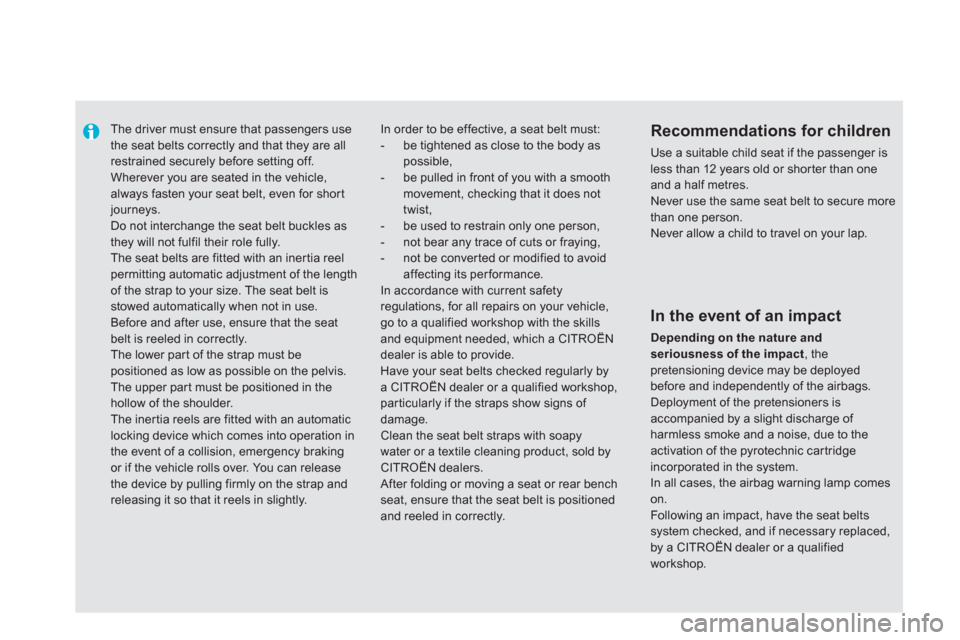
The driver must ensure that passengers usethe seat belts correctly and that they are allrestrained securely before setting off. Wherever you are seated in the vehicle, always fasten your seat belt, even for short journeys.
Do not interchange the seat belt buckles as they will not fulfil their role fully.
The seat belts are fitted with an inertia reel permitting automatic adjustment of the length of the strap to your size. The seat belt isstowed automatically when not in use.
Before and after use, ensure that the seatbelt is reeled in correctly.
The lower part of the strap must be positioned as low as possible on the pelvis.
The upper par t must be positioned in the hollow of the shoulder.
The inertia reels are fitted with an automatic locking device which comes into operation inthe event of a collision, emergency braking or if the vehicle rolls over. You can release the device by pulling firmly on the strap and releasing it so that it reels in slightly.
Recommendations for children
Use a suitable child seat if the passenger is
less than 12 years old or shor ter than one and a half metres.Never use the same seat belt to secure more than one person. Never allow a child to travel on your lap.
In order to be effective, a seat belt must:
- be tightened as close to the body as possible,
- be pulled in front of you with a smooth movement, checking that it does nottwist,
- be used to restrain only one person,
- not bear any trace of cuts or fraying,
- not be converted or modified to avoidaffecting its per formance.
In accordance with current safetyregulations, for all repairs on your vehicle, go to a qualified workshop with the skills and equipment needed, which a CITROËN dealer is able to provide.
Have your seat belts checked regularly by a CITROËN dealer or a qualified workshop, particularly if the straps show signs of damage. Clean the seat belt straps with soapywater or a textile cleaning product, sold by CITROËN dealers.
After folding or moving a seat or rear benchseat, ensure that the seat belt is positioned and reeled in correctly.
In the event of an impact
Depending on the nature and seriousness of the impact
, thepretensioning device may be deployedbefore and independently of the airbags.Deployment of the pretensioners isaccompanied by a slight discharge of harmless smoke and a noise, due to theactivation of the pyrotechnic car tridge incorporated in the system. In all cases, the airbag warning lamp comeson. Following an impact, have the seat belts system checked, and if necessary replaced,
by a CITROËN dealer or a qualified workshop.
Page 195 of 364
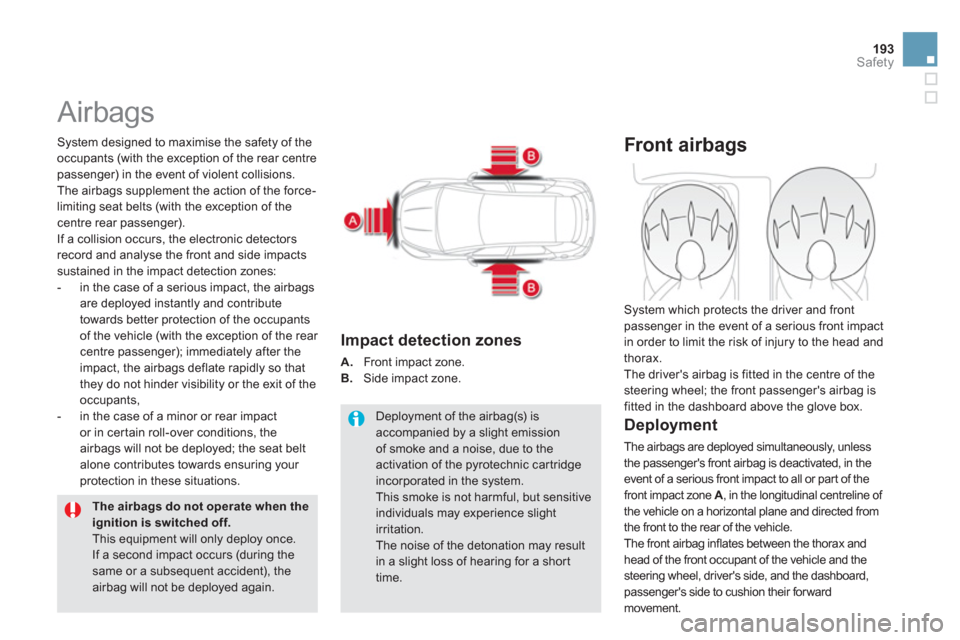
193Safety
Airbags
System designed to maximise the safety of the
occupants
(with the exception of the rear centrepassenger) in the event of violent collisions.
The airbags supplement the action of the force-
limiting seat belts (with the exception of the centre rear passenger).
I
f a collision occurs, the electronic detectors
record and analyse the front and side impacts sustained in the impact detection zones:
- in the case of a serious impact, the airbagsare deployed instantly and contribute
towards better protection of the occupants
of the vehicle
(with the exception of the rear centre passenger); immediately after the
impact, the airbags deflate rapidly so that
they do not hinder visibility or the exit of the
occupants,
- in the case o
f a minor or rear impact
or in cer tain roll-over conditions, the
airbags will not be deployed; the seat beltalone contributes towards ensuring your protection in these situations.
The airbags do not operate when the ignition is switched off.
This equipment will only deploy once. If a second impact occurs (during thesame or a subsequent accident), the airbag will not be deployed again.
Deployment of the airbag(s) is accompanied by a slight emission of smoke and a noise, due to theactivation of the pyrotechnic cartridgeincorporated in the system.This smoke is not harmful, but sensitiveindividuals may experience slight irritation.
The noise of the detonation may resultin a slight loss of hearing for a shor ttime.
Impact detection zones
A.
Front impact zone.B.
Side impact zone.
Front airbags
Deployment
The airbags are deployed simultaneously, unless
the passenger's front airbag is deactivated, in the event of a serious front impact to all or part of thefront impact zone A , in the longitudinal centreline of
the vehicle on a horizontal plane and directed from
the front to the rear of the vehicle.
The front airbag inflates between the thorax and
head of the front occupant of the vehicle and the steering wheel, driver's side, and the dashboard,
passen
ger's side to cushion their for ward
movement. S
ystem which protects the driver and front
passenger in the event of a serious front impact
in order to limit the risk of injury to the head and
thorax.
The driver's airbag is fitted in the centre of the steering wheel; the front passenger's airbag isfitted in the dashboard above the glove box.
Page 197 of 364
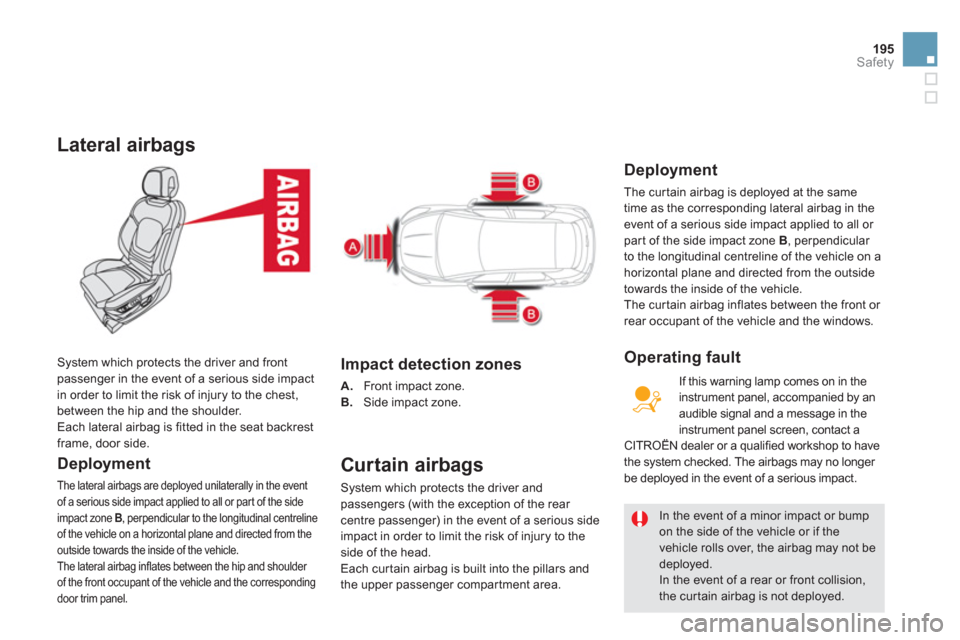
195
Safety
Lateral airbags
Deployment
The lateral airbags are deployed unilaterally in the event
of a serious side impact applied to all or par t of the side
impact zone B, perpendicular to the longitudinal centreline
of the vehicle on a horizontal plane and directed from the outside towards the inside of the vehicle.
The lateral airbag inflates between the hip and shoulder
of the front occupant of the vehicle and the corresponding
door trim panel.
System which protects the driver and frontpassenger in the event of a serious side impact
in order to limit the risk of injury to the chest,
between the hip and the shoulder.
Each lateral airba
g is fitted in the seat backrest
frame, door side.
Impact detection zones
A. Front impact zone.
B. Side impact zone.
Curtain airbags
System which protects the driver and passengers (with the exception of the rear centre passenger) in the event of a serious sideimpact in order to limit the risk of injury to the side of the head. Each curtain airbag is built into the pillars and
the upper passenger compar tment area.
In the event of a minor impact or bump on the side of the vehicle or if the
vehicle rolls over, the airbag may not be deployed.
In the event of a rear or front collision, the cur tain airbag is not deployed.
Deployment
The cur tain airbag is deployed at the same
time as the corresponding lateral airbag in the event of a serious side impact applied to all or
par t of the side impact zone B , perpendicular
to the longitudinal centreline of the vehicle on a
horizontal plane and directed from the outside
towards the inside of the vehicle.
The cur tain airbag inflates between the front or
rear occupant of the vehicle and the windows.
If this warnin
g lamp comes on in the
instrument panel, accompanied by an audible signal and a message in the instrument panel screen, contact aCITROËN dealer or a qualified workshop to have
the system checked. The airbags may no longer
be deployed in the event of a serious impact.
Operating fault
Page 202 of 364
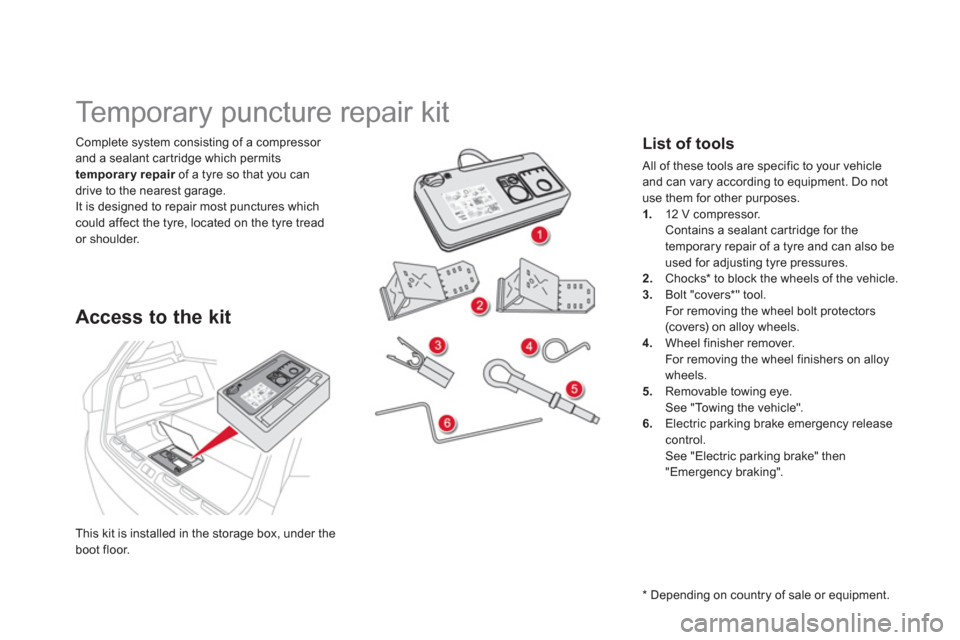
This kit is installed in the storage box, under the boot floor.
Complete system consisting of a compressor
and a sealant car tridge which permits
temporary repair of a tyre so that you can rdrive to the nearest garage.
It is designed to repair most punctures which could affect the tyre, located on the tyre tread
or shoulder.
Temporary puncture repair kit
Access to the kit
List of tools
All of these tools are specific to your vehicle
and can vary according to equipment. Do not
use them for other purposes.
1. 12 V compressor.
Contains a sealant cartridge for the
temporary repair of a tyre and can also be
used for adjusting tyre pressures. 2.Chocks * to block the wheels of the vehicle.3.Bolt "covers *
" tool.
For removing the wheel bolt protectors (covers) on alloy wheels. 4. Wheel finisher remover.
For removing the wheel finishers on alloywheels.
5. Removable towing eye.
See "Towing the vehicle".
6.Electric parking brake emergency releasecontrol.
See "Electric parking brake" then
"Emergency braking".
*
Dependin
g on country of sale or equipment.
Page 206 of 364

2. Infl ation �)
Connect the compressor's electric plug to
the vehicle's 12 V socket.�) Star t the vehicle again and leave the engine running.
�)Adjust the pressure using the compressor (to inflate: switch B
in position "I"
; to deflate: switch B
in position "O"and press button C), in accordance with the vehicle's
tyre pressure label (located on the left hand
door aperture).
A loss of pressure indicates that the
puncture has not been fully plugged; contact a CITROËN dealer or qualified
workshop for assistance.�)Remove and stow the kit.
�)Drive at reduced speed (50 mph [80 km/h] max) limiting the distance travelled toapproximately 120 miles (200 km).
As soon as possible, go to a CITROËNdealer or a qualified workshop.You must inform the technician that you have used this kit. After inspection, the technician will advise you on whether the tyre can be repaired or if it must be replaced.
�)Turn the selector Ato the "air" position.�)Uncoil the black pipe Hfully. �)Connect the black pipe to the
valve of the wheel.
Page 207 of 364
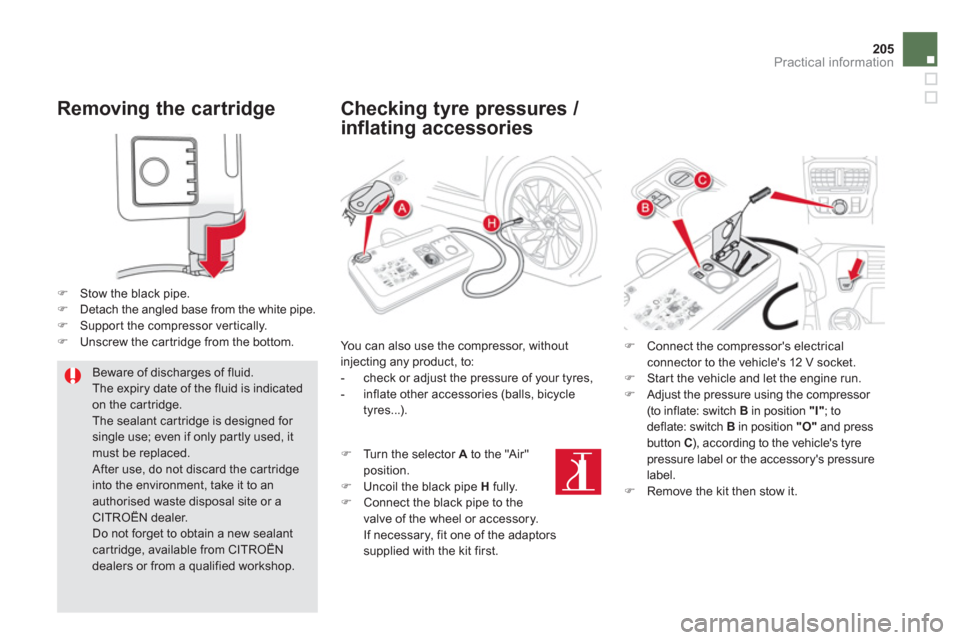
205
Practical information
Removing the cartridge
�)Stow the black pipe. �)Detach the angled base from the white pipe.�)Suppor t the compressor ver tically.�)Unscrew the car tridge from the bottom.
Beware of discharges of fluid.
The expiry date of the fluid is indicated on the car tridge.
The sealant car tridge is designed for
single use; even if only partly used, itmust be replaced. After use, do not discard the car tridgeinto the environment, take it to an authorised waste disposal site or a CITROËN dealer.
Do not forget to obtain a new sealantcartridge, available from CITROËN dealers or from a qualified workshop.
Checking tyre pressures /
inflating accessories
You can also use the compressor, withoutinjecting any product, to:
- check or adjust the pressure of your tyres,
- inflate other accessories (balls, bicycle
tyres...).
�)
Turn the selector Ato the "Air"
position.
�) Uncoil the black pipe H
fully.�)
Connect the black pipe to the
valve of the wheel or accessory.
If necessary, fit one of the adaptorssupplied with the kit first.
�) Connect the compressor's electrical connector to the vehicle's 12 V socket. �)
Star t the vehicle and let the engine run. �)
Adjust the pressure using the compressor (to inflate: switch B
in position "I"
; to deflate: switch Bin position "O"and press button C ), according to the vehicle's tyrepressure label or the accessory's pressure
label.�) Remove the kit then stow it.
Page 208 of 364
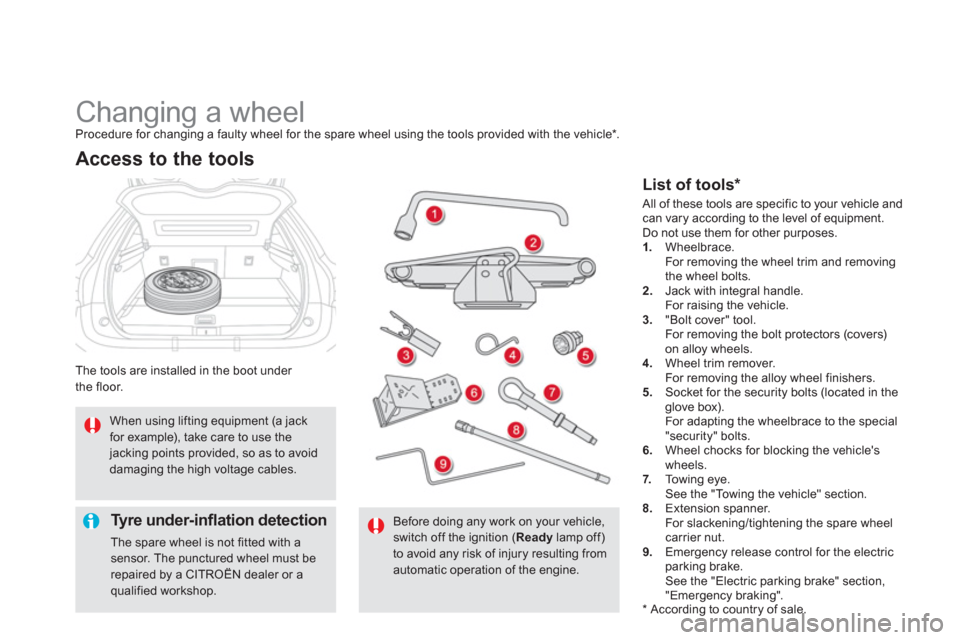
Changing a wheel Procedure for changing a faulty wheel for the spare wheel using the tools provided with the vehicle *
.
Th
e tools are installed in the boot under
the floor.
Access to the tools
List of tools *
Tyre under-infl ation detection
The spare wheel is not fitted with a sensor. The punctured wheel must berepaired by a CITROËN dealer or a
qualified workshop.
Before doing any work on your vehicle,switch off the ignition ( Ready
lamp off)to avoid any risk of injury resulting fromautomatic operation of the engine.
When using lifting equipment (a jack
for example), take care to use the jacking points provided, so as to avoiddamaging the high voltage cables.
All of these tools are specific to your vehicle and can vary according to the level of equipment.
Do not use them for other purposes. 1. Wheelbrace.
For removing the wheel trim and removingthe wheel bolts. 2.Jack with integral handle.
For raising the vehicle.3."Bolt cover" tool.
For removing the bolt protectors (covers)
on alloy wheels.4. Wheel trim remover.
For removing the alloy wheel finishers.
5. Socket for the security bolts (located in the glove box).
For adapting the wheelbrace to the special"security" bolts.
6.Wheel chocks for blocking the vehicle's
wheels.7. Towing eye.
See the "Towing the vehicle" section.8.Extension spanner.
For slackening/tightening the spare wheelcarrier nut. 9. Emergency release control for the electric parking brake.
See the "Electric parking brake" section, "Emergency braking".
*
According to country of sale.